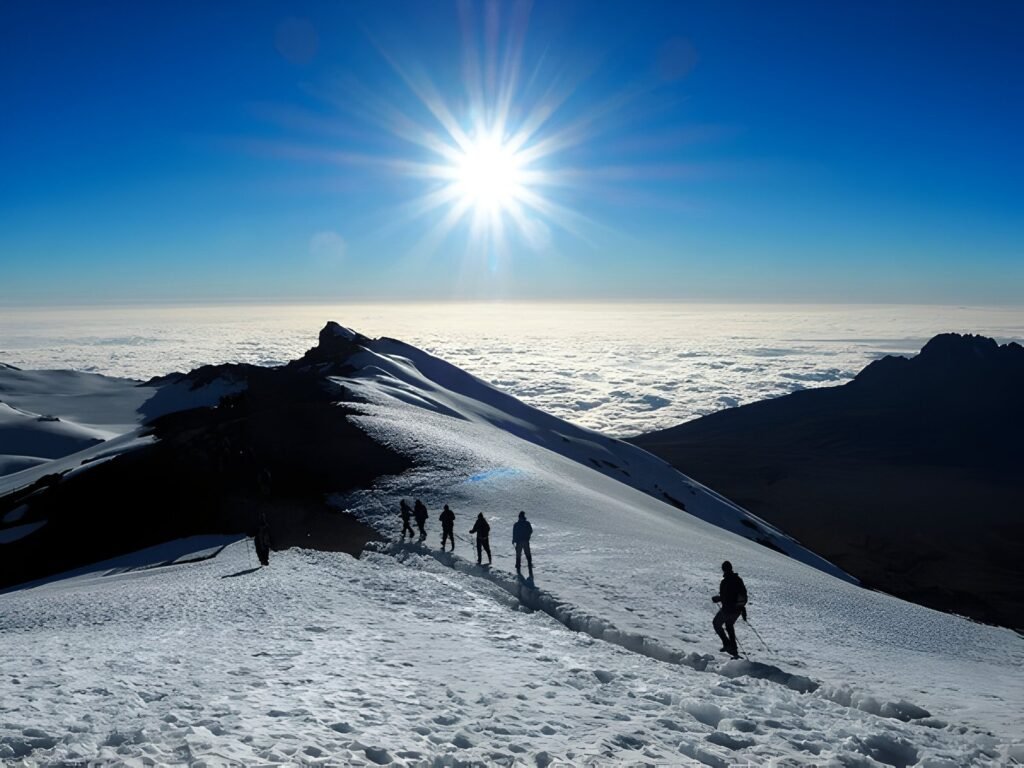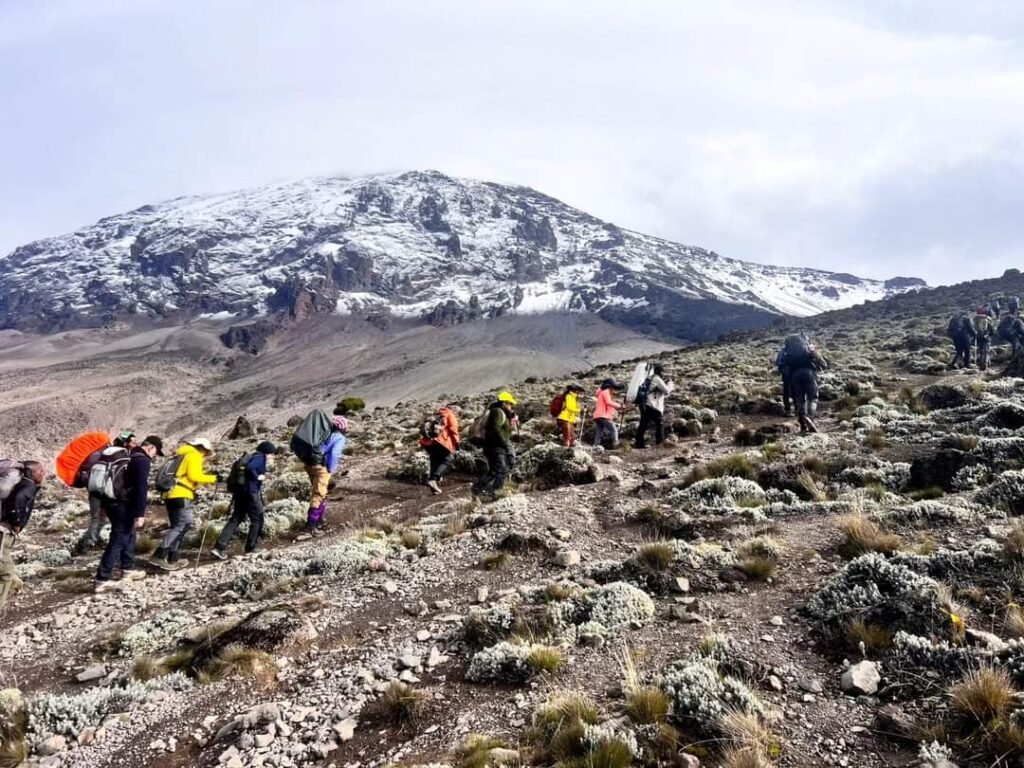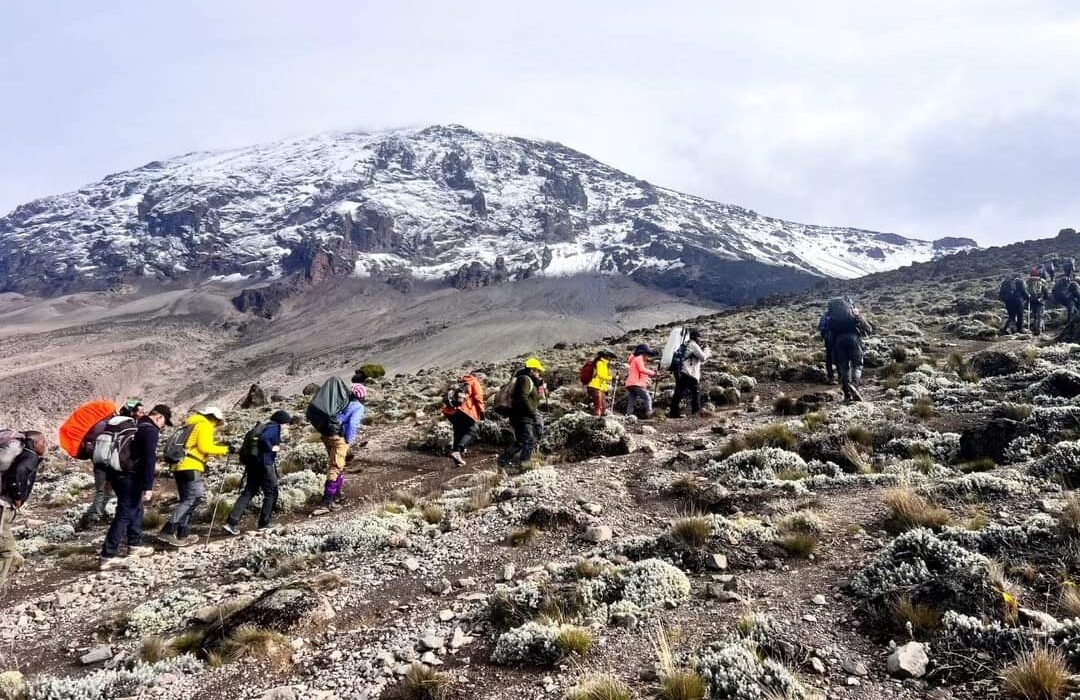6-Day and 7-Day Rongai Route Packages offers a unique and quieter ascent to Mount Kilimanjaro, approaching the mountain from the north, near the Kenyan border. For climbers looking for a less crowded experience and a more gradual ascent, the Rongai Route is an excellent choice. With beautiful, diverse landscapes and a reputation for being the driest route on Kilimanjaro, it’s ideal for trekking during the rainy season. The 6-day and 7-day Rongai Route packages offer the perfect blend of adventure and acclimatization for a successful Kilimanjaro climb in 2025.
This guide will take you through the details of both the 6-day and 7-day Rongai Route packages, including itinerary options, preparation tips, and what to expect on your Kilimanjaro journey.

6-Day and 7-Day Rongai Route Packages Why Choose ?
The Rongai Route is the only route that approaches Kilimanjaro from the northern side. It offers a distinct experience compared to the more popular southern routes like the Machame Route and Marangu Route. Here’s why many climbers prefer the Rongai Route:
1. Quieter and Less Crowded
While routes like Machame and Marangu can get busy, the Rongai Route is much quieter, providing a more peaceful trek. It’s an excellent choice for climbers seeking a more intimate experience with the mountain.
2. Gradual Ascent for Better Acclimatization
The Rongai Route offers a more gradual ascent compared to other routes, giving climbers more time to acclimatize. This helps reduce the risk of altitude sickness and increases the likelihood of reaching the summit successfully.
Learn more about the importance of acclimatization on high-altitude climbs from the Altitude Research Center.
3. Stunning and Diverse Scenery
Although the Rongai Route is less popular, it doesn’t lack in scenic beauty. You’ll trek through savannah, rainforests, alpine moorlands, and eventually reach the high-altitude desert near the summit. The views from the northern side of the mountain are particularly striking, offering different perspectives of Kibo Peak and the surrounding plains.
For more about Kilimanjaro’s landscapes and climate zones, visit National Geographic’s Kilimanjaro overview.
6-Day and 7-Day Rongai Route Packages: Itinerary Overview
The 6-day and 7-day Rongai Route packages provide flexibility depending on your pace and acclimatization needs. Both packages offer an incredible experience, but the 7-day option gives you an extra day to adjust to the altitude.
6-Day Rongai Route Package
The 6-day package is ideal for trekkers who are confident in their ability to acclimatize quickly. Here’s a breakdown of the daily itinerary:
Day 1: Rongai Gate to Simba Camp (8 km)
- Elevation: 2,000 meters to 2,650 meters
- Trekking Time: 4-5 hours
Start your trek at Rongai Gate and hike through farmland and pine forests before reaching Simba Camp, where you’ll spend the night.
Day 2: Simba Camp to Second Cave (6 km)
- Elevation: 2,650 meters to 3,450 meters
- Trekking Time: 3-4 hours
Day two takes you through the moorland zone, with expansive views of Mawenzi Peak and Kibo in the distance. You’ll reach Second Cave Camp by midday, allowing for an afternoon of rest and acclimatization.
Day 3: Second Cave to Kikelewa Camp (5 km)
- Elevation: 3,450 meters to 3,600 meters
- Trekking Time: 3-4 hours
After a short but steep climb, you’ll arrive at Kikelewa Camp near the base of Mawenzi Peak, surrounded by striking alpine landscapes.
Day 4: Kikelewa Camp to Mawenzi Tarn (5 km)
- Elevation: 3,600 meters to 4,330 meters
- Trekking Time: 4-5 hours
Today’s trek takes you to Mawenzi Tarn Camp, located in a stunning valley beneath the towering cliffs of Mawenzi Peak. This is one of the most scenic camps on the mountain, offering a great spot for acclimatization.
Day 5: Mawenzi Tarn to Kibo Hut (8 km)
- Elevation: 4,330 meters to 4,700 meters
- Trekking Time: 5-6 hours
You’ll cross the Saddle, a high-altitude desert between Mawenzi and Kibo Peaks. This day is longer and prepares you for the summit push the following night.
Day 6: Kibo Hut to Uhuru Peak (5.7 km), Descend to Horombo Hut (14 km)
- Elevation: 4,700 meters to 5,895 meters (summit), descending to 3,720 meters
- Trekking Time: 10-15 hours (summit day)
Summit day begins at midnight with a steep climb to Uhuru Peak, the highest point in Africa. After celebrating your achievement at the summit, you’ll descend to Horombo Hut for a well-deserved rest.
Day 7: Horombo Hut to Marangu Gate (18 km)
- Elevation: 3,720 meters to 1,830 meters
- Trekking Time: 6-7 hours
Complete your descent through the lush rainforest to Marangu Gate, where you’ll receive your summit certificate before returning to Moshi.
For more tips on preparing for summit day, visit this Kilimanjaro summit guide.
7-Day Rongai Route Package
The 7-day package follows the same itinerary as the 6-day trek but includes an additional day for better acclimatization. On Day 4, you’ll have an extra day to explore the area around Mawenzi Tarn, allowing your body more time to adjust to the altitude before continuing to Kibo Hut.
Day 4: Acclimatization Day at Mawenzi Tarn
You’ll spend a second night at Mawenzi Tarn Camp, with optional short hikes to higher elevations to help with acclimatization.
This extra day significantly improves your chances of reaching the summit by reducing the risk of altitude sickness. Learn more about the importance of acclimatization from the Altitude Research Center.
6-Day and 7-Day Rongai Route Packages What’s Included ?
Both the 6-day and 7-day Rongai Route packages are designed to provide a seamless, stress-free experience for climbers. Here’s what’s included:
1. Expert Guides and Porters
You’ll be led by certified, experienced guides who know the Rongai Route inside and out. Porters will carry your gear, allowing you to focus on the climb.
For more about what guides and porters do on Kilimanjaro, check out Eddy Tours & Safaris.
2. All Meals and Drinking Water
You’ll receive freshly prepared meals every day, along with purified water to keep you hydrated during the trek.
3. Camping Equipment
High-quality tents and sleeping pads are provided to ensure a comfortable stay at each camp.
4. Park Fees and Permits
All required Kilimanjaro National Park fees are included, covering your entry, camping, and conservation fees.
Learn more about Kilimanjaro National Park and its conservation efforts at UNESCO’s World Heritage site.
5. Transportation
Transportation from Moshi or Arusha to the starting point at Rongai Gate, and back from Marangu Gate at the end of the trek, is included.
6. Safety Equipment
Safety is a top priority. Your package includes essential safety gear such as oxygen tanks, first aid kits, and health monitoring throughout the trek.
For more on trekking safety, read this Outdoor Trekking Safety Guide.
6-Day and 7-Day Rongai Route Packages : Preparing for Your 2025 Rongai Route Kilimanjaro Climb
1. Physical Fitness
Climbing Kilimanjaro requires good physical fitness. Start training several months before your trip, focusing on cardio exercises like hiking, running, or cycling, as well as strength training for your legs and core.
For a complete training plan, check out this Kilimanjaro training guide.
2. Mental Preparation
The summit night is the most challenging part of the trek, requiring mental resilience to push through cold temperatures and fatigue. Stay positive and remember that reaching the summit is a once-in-a-lifetime achievement.
3. Packing List
Make sure you pack all the essential gear for a high-altitude trek:
- Waterproof hiking boots (well broken in).
- Thermal clothing layers for warmth at high altitudes.
- Waterproof jacket and pants to protect against rain and wind.
- Trekking poles for added stability on steep terrain.
- Sunscreen and sunglasses to protect from UV exposure.
For a full packing list, visit Ultimate Kilimanjaro’s gear guide.

6-Day and 7-Day Rongai Route Packages : Frequently Asked Questions (FAQs)
1. How difficult is the Rongai Route?
The Rongai Route is considered a moderately challenging trek. Its gradual ascent makes it a bit easier on the body compared to steeper routes, but summit night can still be physically demanding.
2. What is the success rate of the Rongai Route?
The success rate for the Rongai Route is around 80% for the 6-day package and 90% for the 7-day package, thanks to the extra day for acclimatization.
3. Do I need technical climbing experience?
No, the Rongai Route is a non-technical trek, meaning you don’t need any specialized climbing skills. However, you should be physically fit and prepared for long days of trekking at high altitudes.
4. When is the best time to climb Kilimanjaro?
The best times to climb Kilimanjaro are during the dry seasons: January to March and June to October. These months offer the most stable weather for trekking.
For more on Kilimanjaro’s weather, visit BBC’s Kilimanjaro climate guide.
5. Can I join a group climb on the Rongai Route?
Yes, solo travelers can join a group climb, which is a great way to meet new people and share the experience.
6-Day and 7-Day Rongai Route Packages Conclusion
For more information or to book your Rongai Route Kilimanjaro Climb Package, visit Kilimanjaro Climb Specialist and Eddy Tours & Safaris.

